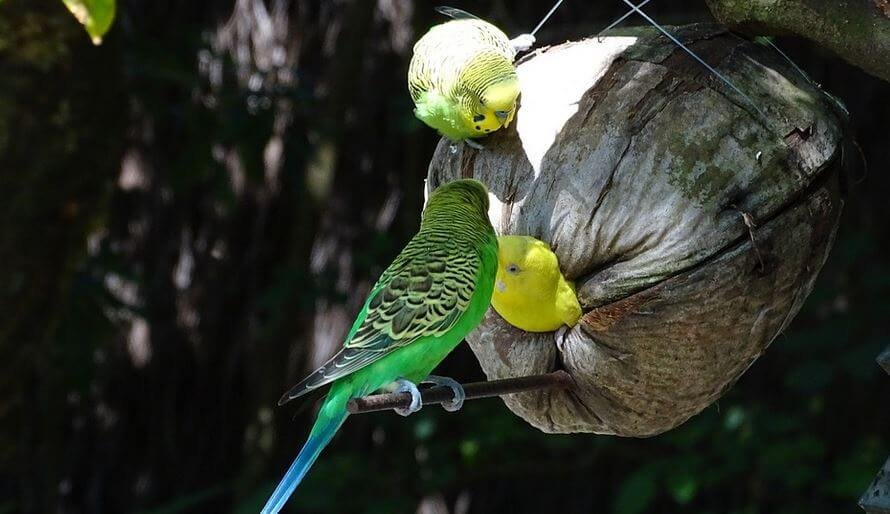Budgies in the wild don’t build nests. Instead, they find homes in tree hollows where they breed. Therefore, you may be wondering; do budgies need nesting material if you let them breed?
Technically, budgies don’t need nesting materials. But it’s vital to provide a nesting box with nesting materials for the female to lay eggs. Of course, if you decide to breed your budgies.
The perfect nesting materials keep eggs safe and warm while absorbing moisture. Also, they reduce foul odor from the birds’ droppings.
In the rest of this article, I’ll discuss why budgies may need nesting material. I’ll also discuss how to prepare your budgie for breeding. Keep reading to learn!
Do Budgies Need Nesting Material?
Generally, budgies may not necessarily need nesting materials. However, nesting materials are essential for many reasons when the birds are breeding.
Some of the benefits of nesting materials for budgies include:
- The budgie needs to feel comfortable while sitting on the eggs
- The materials help absorb moisture while preventing any element damage
- They keep the eggs warm
- They keep the eggs well protected
By providing the nesting materials, you improve your bird’s stakes of laying eggs successfully, hatching, and raising her babies well.
Remember that a female budgie sits on the eggs for 18-23 days. After hatching, she may continue covering her chicks for more days.
Female budgies will defecate on the bedding. Their chicks will also spend 1-2 months before they can come from the nest. They also continue defecating on the nesting material.
If you use poor nesting materials, you can be guaranteed a rough breeding session for your budgie. That’s when diseases hit your chick budgies because there was probably a moisture leakage.
The chicks may develop splayed feet—a condition that occurs because of the chicks standing on hard, flat surfaces.
Find Out: Why Is My Budgie Panting? 6 Main Reasons
What Do Budgies Like in Their Nesting Box?

Budgies like their nesting box to be spacious, comfortable, dark, clean, and warm enough to keep them and their eggs warm. Let’s look at these qualities in detail right next.
1. Enough Space
When preparing a nesting box for your broody budgie, keep it spacious. It should accommodate the two birds just fine.
So speaking, don’t make the nesting box too large as well. Make a moderately-sized cage that would easily facilitate warmth for the eggs.
Also Read: How Can You Tell If Your Budgie Is Overweight? 5 Sure Ways
2. Comfortable Lining Material
The type of material you put in the cage may please or displease your budgie friend. In the event of the latter, it’s not uncommon to see the bird remove from the box anything it doesn’t like.
A combination of dry grass, feathers, and small dead twigs is a good arrangement. You can help make the bedding, but it’s unnecessary. The bird will figure out how to line its nest once it has suitable materials.
Place a perch just outside the nesting box. They’ll use it when lining their nest.
3. A Dark Environment
A dark, quiet, secluded area is perfect for a breeding budgie. So, make the nesting box dark to enhance your budgie’s privacy needs. Darkness also enhances a sense of security for the budgies.
In that regard, make only small entrance and exit holes on the boxes. These should help facilitate the bird’s movement in and out of the box without letting in much light.
4. Cleanliness
Budgies would love to stay and breed in clean environments. That’s why you should ensure that the nesting box is easily accessible for cleaning. Keep it free from excess waste like droppings and debris.
Cleaning is primarily necessary when the chicks hatch. These chicks and their mother usually drop a lot of waste. To avoid incidences of diseases, you need to clean the box regularly before letting your flock in again.
5. Warm and Humid Environment
Budgies naturally prefer staying in warm and humid environments. This should be provided, especially when the female budgie is breeding.
High temperatures promote the successful hatching of eggs. So, you want to place the nesting box in a warm area, away from any drafts and cold spots. The cage itself should be located in a suitable site.
What Is the Best Material for Budgie Nesting?

Dried grass, dead leaves, wood shavings and pellets, and shredded paper are the best materials for budgie nesting. These materials provide sufficient warmth in the nest while absorbing moisture.
Let’s look at each material in details below:
1. Wood Shavings And Wood Pellets
If you’re wondering about the best material for budgie nesting, check with wood shavings and pellets. Of course, both are untreated.
Wood shavings are convenient, easy to find, and usually affordable. The same applies to wood pellets.
Besides, these nesting materials are ideal for absorbing moisture. Moreover, they’re not toxic to cause harm to your birds and their chicks once they hatch.
Additionally, untreated wood shavings and wood pellets are soft and provide the comfort your budgies need for breeding.
However, the dark side of wood shavings is the mess they cause in short spans. So, you need to clean the nesting box regularly to avoid mold growth.
Important: What Is a Lutino Budgie? What You Need to Know
2. Dried Grass, Dead Leaves, and Twigs
Other excellent non-toxic nesting materials include dried grass, dead leaves, and twigs. In the wild, budgies find these materials with relative ease.
You can collect this assortment of materials from your backyard. Remember, they should have dried well without moisture and pathogens attached to them.
These materials are excellent for budgie nesting. However, they don’t preserve heat at the levels of other options like wood shavings or sawdust.
You can also use straw or hay. But it means more work for the budgie. It must break the long strands into small bits suitable for lining the nest.
From an expert view, extra biting or chewing work for the agitated budgie can help with the breeding course. Otherwise, cut the long straws and hay into short lengths before placing them in the nest.
3. Shredded Paper
Once you can’t find the materials mentioned above or want to create a mix, consider shredded paper. Use old newspapers, paper towels, or other recycled paper.
The good thing is that they’re readily available at almost no cost. Also, paper is soft and comfortable and traps enough heat for warmth.
Plus, replacing paper is pretty straightforward. Ensure the paper you intend to use for bedding is not bleached with agents such as chlorine. Otherwise, it can be harmful to chicks.
On the downside, paper can be damaged easily, especially when it comes into contact with moisture. Therefore, it’s advisable to only use paper if you don’t have other options.
Will Budgies Lay Eggs Without a Nesting Box?

Budgies may lay eggs without a nesting box. But you need to provide one for a successful breeding session. The eggs need to be safe and warm. That can only be possible with a suitable nest box.
If it’s your first time having a budgie, concerns about laying eggs are common. Given the budgies’ natural breeding behavior, you may be confused about whether there should be any need for a nesting box.
Sometimes, the budgie won’t lay eggs as the nest almost becomes a crucial stimulant. Although this can happen, it’s never always the case and varies among different birds.
Budgies, of course, male and female, need the perfect breeding environment. Therefore, give them a well-balanced diet, good exercise, and a spacious cage; the rest will be history.
A nesting box is essential, but it doesn’t determine absolutely whether your budgie lays eggs or not. In the interest of a well-organized breeding program, ensure you set up a nesting box.
The box ensures the bird’s eggs are protected and warm. After they hatch, the chicks also need a suitable environment for survival. That can only be possible in a well-prepared nest box.
When Should I Put a Nesting Box for Budgies?
You should put a nesting box for budgies once you know they’re adults. Generally, ensure your budgie is two years old before you have it paired with a male. But you must have decided to start a new flock to let the birds start breeding.
While budgie enthusiasts may ask the best time to put a nesting box for budgies, it’s never always a big deal.
If your budgie is young, keep it away from the male. You won’t need to put a nesting box in the cage. A nest box encourages breeding activities.
For adult budgies that have hatched before, give them a six-month rest. Egg laying is a draining process for hens, especially when it becomes chronic in small birds. It takes plenty of protein and calcium from the female budgie’s system.
Once they hatch and the chicks are of age, remove the nesting box and wait for the next scheduled breeding. Remember, you’re solely responsible for your bird’s breeding program.
The birds are under your care and therefore do not receive environmental signals to indicate a breeding season has started or ended. You control their mating, egg-laying, and hatching.
You can put your nesting box any time you wish. As long as you have provided the favorable conditions of:
- Increased daylight
- Warm environment
- Enough food in balanced proportions
- Quiet, private environment
On the other hand, if you reverse these conditions, your budgies will stop breeding engagements.
Final Thoughts
So, do budgies need nesting material?
While budgies may not necessarily need nesting material for survival, providing them with appropriate nesting materials can greatly enhance their overall well-being.
From creating a cozy and secure environment to stimulating their natural behaviors, nesting materials offer a myriad of benefits for budgies. Thus, by understanding their needs and providing suitable materials, you can create a nurturing space that encourages their natural nesting instincts.

